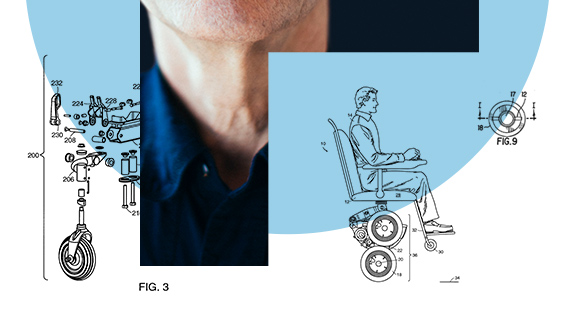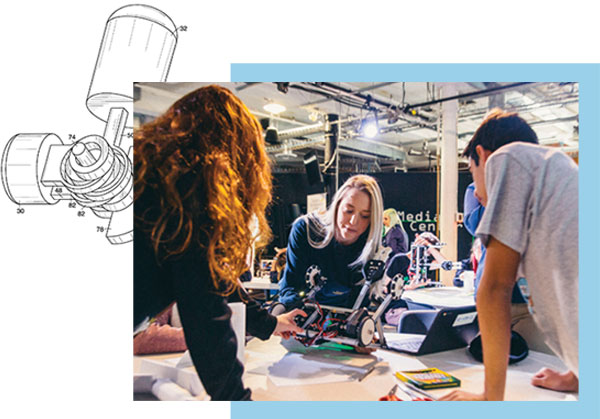DEAN KAMEN ISN’T AFRAID OF FAILURE
Photos by Christian Gilbert


Spend three minutes in the presence of Dean Kamen, and it’ll become abundantly clear that he’s the smartest guy in the room. (Google him ahead of time, and you won’t even need those three minutes.) But when we ask the prolific inventor to talk to us about failure, he fesses up with a chuckle: “It’s not my favorite thing, but I happen to be an expert on it through experience.” Despite his 440+ patents and slew of honors and awards, he also manages to be warm, humble, and refreshingly kind.
Kamen has had the chance to tackle some big problems throughout his career—the complex, meaty, saving-the-world kind that aren’t for the faint of heart or the failure-averse. He’s explored the far reaches of his brain to dream up a wearable insulin pump. A bionic arm named after a Star Wars character. A wheelchair that climbs stairs and raises its user to standing height. And, no big deal, a solution to the world’s clean water crisis. There’s also the Segway, widely considered Kamen’s most commercially noteworthy success, and his latest efforts are in regenerative medicine, on a grow-a-new-kidney-when-yours-stops-working kind of scale.
Then there’s the initiative Kamen looks at as his legacy, the “invention” he’s often said he’s proudest of. FIRST®, short for “For Inspiration and Recognition of Science and Technology,” is a nonprofit he founded to inspire the next generation of inventors and STEM thinkers. The global organization develops team-based robotics challenges that inspire students in grades K–12 to explore the innovation process while they learn valuable STEM, teamwork, and problem-solving skills. They aim to bring all the energy and excitement of sports—think marching bands, cheering crowds, and champions hoisted up on shoulders—to topics that can sometimes feel dry in a traditional classroom setting. (EF’s Boston STEM tour includes a workshop at FIRST HQ.)
So, how does someone as brilliant as Kamen, whose name is thrown around in the company of guys like Franklin, Edison, and Einstein, square his wild success with the inevitability of failure? And what does that mean for the next generation of inventors and entrepreneurs and try-ers and fail-ers who might perceive success and failure to be mutually exclusive?

The answer starts with a peculiar clock that stands out against the exposed brick walls and wide pine floors in the lobby of Kamen’s DEKA Research & Development Corp. Like most of the concepts Kamen puts forward during our hour-long chat, it takes us a minute to figure it out.
“I’ve spent my whole life with people telling me, ‘You know, Dean, you’re trying to do too many different and crazy things,’” Kamen explains. “‘For every two steps ahead, you take one step backward.’” But his inner mathematician kept nagging him: “‘Two steps ahead, one step backward’ is exactly the same, mathematically, as ‘For every step backward, you take two steps ahead.’ A step backward is a failure, but what if, for every step backward, you take two steps ahead?” A little dizzying, maybe—but the logic is sound. By Dean’s math, every failure you endure puts you two steps ahead of those who didn’t try in the first place.
Enter the clock, built by Kamen himself to illustrate the point: It runs at three times normal speed, its super-charged second hand traveling one revolution back in 20 seconds and two revolutions forward in the remaining 40 seconds, resynchronizing once per minute to keep perfect time. Despite the clock’s regular regressions, time keeps on ticking—and new ideas continue to advance. “[The clock is] very symbolic of my life,” says Kamen. “I fail a lot, but you only have to be successful once in a while with a big idea.”
Need help wrapping your brain around how Kamen’s clock works? Watch his real-life explanation below.

Those big wins are what make headlines, which can feed the perception that successful inventors follow a discouragingly linear path from idea to solution. “I would wildly agree with you that the term inventor or entrepreneur is equated with success, maybe even instant success and big success. It’s a very positive word,” says Kamen. “In reality, being an inventor is mostly trying a new and different thing. Since it’s new and different, there’s no roadmap. There’s no answer in the back of the book.” And getting comfortable with working in that sort of intellectual gray area is critical for someone who’s exploring something that’s never been done before.
For Kamen and his team at DEKA, progress is about figuring out what doesn’t work before landing on something that does. “I have 500 engineers here and we try to solve really difficult problems. So we find lots and lots of ways how not to solve that problem,” Kamen explains. “There’s many, many ways it didn’t work, and then the one way it worked.” Unfortunately, everything leading up to that “one way” often ends up obscured from public view.
With big ideas like the ones the DEKA team tackles come big risk—and Kamen’s okay with that. “I’d rather do things that matter, not make incremental changes that A, don’t matter much or B, that millions of other people would make anyway. I’d rather look back and say, ‘I did that.’” Kamen embraces the opportunity to truly make a difference by achieving something that only he could. And, even if he fails, learning something that might inform a future success makes the attempt worthwhile. “I would rather crash, burn, and fail in a big way and learn a lot—and then move on and maybe succeed,” he admits. “I would rather have either a spectacular failure or a spectacular success than die the warm death of mediocrity.”

Of course, every project has its critics. “A lot of people around you who are watching these failures will give you advice like, ‘Go do something else,’” warns Kamen. There are the naysayers you might expect, sure. But it’s the well-meaning ones—the parents, the teachers, the mentors—who can really derail a budding innovator. “When you think about it,” he explains, “what do moms and dads do? They protect their kids. They never stop doing it. Even when you get old enough that you should be out trying new things, mom and dad want, at all costs, to protect you from any kind of failure.”
In fact, the majority of the social influences that surround each of us are supremely focused on helping us avoid failure. And they can conflict with the fact that innovation, in its purest form, requires it. It’s one of the things FIRST does really well: getting kids comfortable with the fact that maybe the “right answer” hasn’t been invented yet. Or perhaps it doesn’t exist at all.
Here’s Kamen again: “There are some huge advantages in becoming comfortable with failure. A project can fail, but that doesn’t mean the person failed. Because if your project fails but you learned from it, you now know something new and different and unusual from that failure. It gives you a greater probability that you might succeed in a way that others wouldn’t.” Overcoming that social pressure to choose the path of least resistance and experiment on a smaller scale, in a safer space, can often be the first step towards achieving something truly remarkable.

The best part of the kit that FIRST teams receive to define their next project is what it doesn’t include—namely, instructions. That’s by design, explains Kamen. Instead, students are given a problem statement with a solution that’s open to wide interpretation. In the end, “There is no best solution. There are different solutions. This [robot] is better at this, this one is better at that.” Failure isn’t really possible, because no traditional grade is assigned. Instead, what excites Kamen about FIRST competitions is the fact that, “You create something, you put it out there, you compare it to others. You learn, ‘Wow, I should have thought of that.’ [And other teams] are going to look at yours and say, ‘Well, that aspect of what you did is pretty neat.’ But collectively we raise the bar for everybody.”
That approach to learning can feel at odds with where the U.S. education system typically places its focus. Traditionally, “School is about telling you the right way to get to the answers in the back of the book,” says Kamen. “In fact, if you get a different answer—not even a wrong answer, but a different answer—you get a red mark or you don’t get an A.” The goal becomes more about avoiding that D or F, and less about thinking deeply about a problem.
Kamen, who’s dyslexic, compares his early classroom experiences to a “firehose of information.” He struggled to align his interpretation of what it means to really understand a new concept with that of his teachers, who he realized were just looking for what he defined as “familiarity,” or the ability to memorize facts for a test. (Case in point: He’d learn a simple rule of fractions in math class, but still be trying to wrap his brain around “What does it mean to divide zero by zero?” while the rest of the class had moved on to phonics, spelling, or reading.)
That’s not to say Kamen discounts traditional education. Quite the opposite—his mom is a retired teacher. But he concluded that its purpose was to help him amass a baseline set of facts, rules, and general knowledge that, independently, he could then apply to bigger thinking. School is the place where you assemble your toolkit, he reasons. “You have to then go out and say, ‘Now that I’ve got all these tools and I know how to use them, I want to use my imagination and come up with something that’s never been made before.’” But if earning that A is your most important metric, “don’t become an inventor,” Kamen counters. “An inventor rarely gets it right. But if it’s a really good invention, rare is okay.”

So what’s Kamen’s end game in helping develop a new generation of innovators and entrepreneurs who are undaunted by failure? Here’s where the seasoned inventor starts waxing poetic. “In order to create a world where every generation will be better than the one before them,” he explains, it’s critical to foster “smart, educated people that not only have access to these technologies, but they also have to have the courage to try, even if they fail, and pick themselves up again.”
And once that new breed of inventors gets comfortable with failure’s fundamental role in the process of invention, Kamen finds hope in an emerging world of ideas, not things. “In the old world of stuff, if I took the land, you don’t have it. If I took the oil, you don’t have it,” he explains. “But in a world of ideas, if you know the formula to cure cancer with that pill and I have a way to make the internet 10 times faster, and you share your idea with me, now we both know how to cure cancer. If I share my idea with you, we both can have better internet. The world of ideas isn’t a zero-sum game like the world of stuff.” And that kind of world, Kamen concludes, is something worth striving for.
